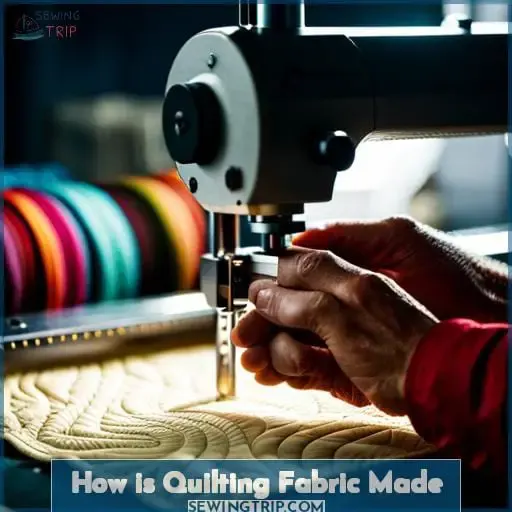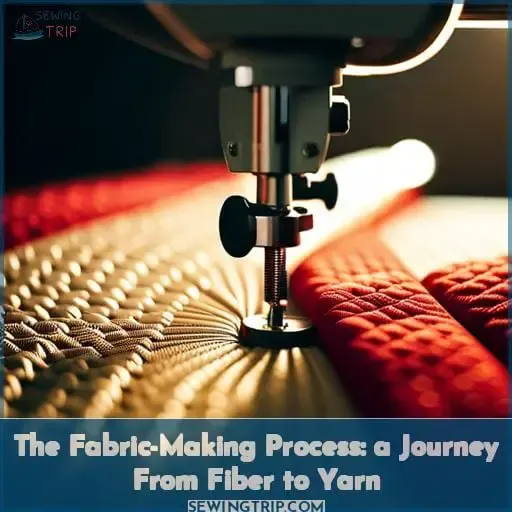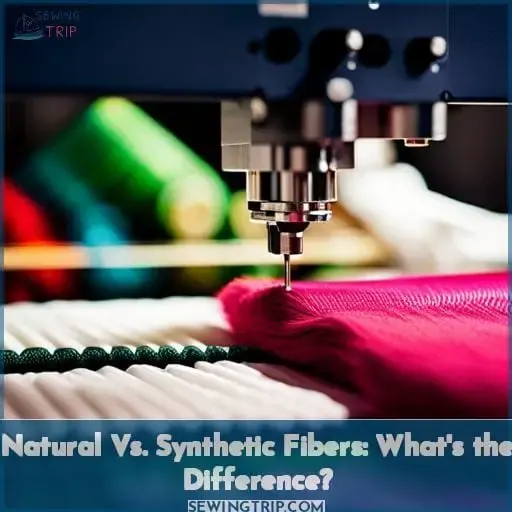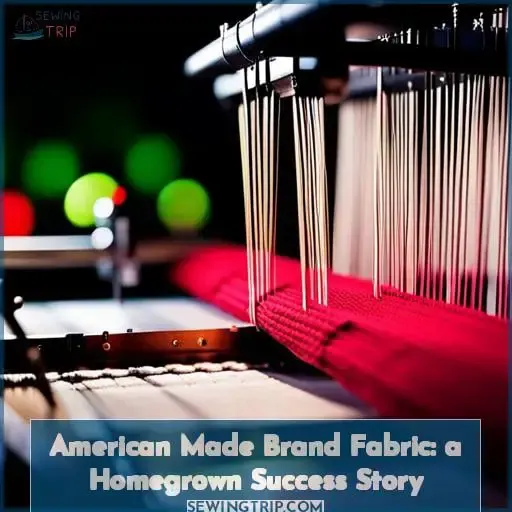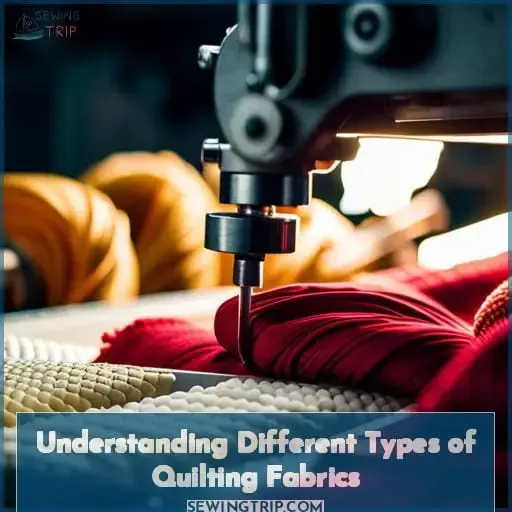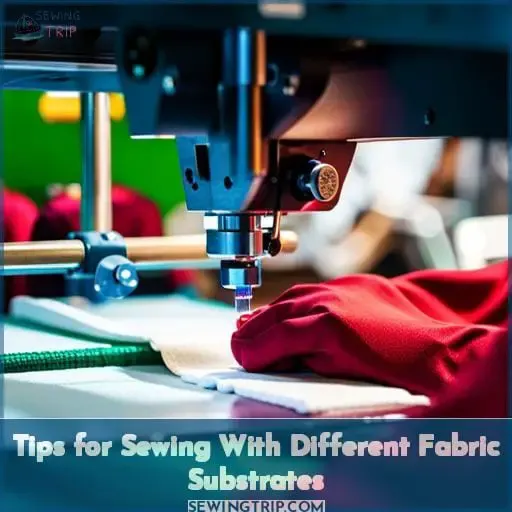This site is supported by our readers. We may earn a commission, at no cost to you, if you purchase through links.
You’ve probably always wondered what goes into making a piece of quilting fabric – and today is the day you find out! Let’s take a journey from fiber to yarn as we explore the process of fabric-making.
From natural fibers like cotton, wool, silk, and linen to synthetic materials like rayon, nylon, and polyester – each type offers its own unique characteristics that will become part of your masterpiece.
We’ll look at where American Made Brand Fabric comes in. This homegrown success story has given rise to new opportunities for farmers and artisans alike.
Finally, let’s discuss some tips for sewing with different types of fabrics so you can confidently create something special that stands out from all other quilts!
Table Of Contents
- Key Takeaways
- The Fabric-Making Process: a Journey From Fiber to Yarn
- Natural Vs. Synthetic Fibers: What’s the Difference?
- American Made Brand Fabric: a Homegrown Success Story
- Understanding Different Types of Quilting Fabrics
- Tips for Sewing With Different Fabric Substrates
- Frequently Asked Questions (FAQs)
- Conclusion
Key Takeaways
- Quilting fabric is made by spinning fibers into yarn and weaving them together into a base fabric. This fabric is then chemically treated and woven with intricate designs.
- Natural fibers such as cotton, silk, and wool are selected for their unique characteristics, while synthetic fibers like rayon, nylon, and polyester are man-made and offer different properties.
- American Made Brand Fabric uses Quilter’s Cotton for strength and smoothness. It offers shorter lead times and cost savings, and provides 97 colors of locally produced fabric grown, spun, and dyed in US mills.
- Different types of quilting fabrics include Quilter’s Weight Cotton, Voile, Cotton Flannel, Quilter’s Linen, and Wool. Each type has its own unique characteristics and uses in quilting projects.
The Fabric-Making Process: a Journey From Fiber to Yarn
Have you ever wondered how quilting fabric is made? The process begins with spinning fibers into yarn, then weaving the yarns together to make a base fabric. Finally, chemical treatments are applied to give the fabric its desired properties and softness needed for quilting projects.
Spinning
You take the first step in transforming raw fibers into yarn when you spin. This ancient technique requires knowledge of fiber sources, spinning tools, and dyeing techniques to perfect the fabric density desired.
For example, American Made Brand Fabric is made using Quilter’s Cotton along with a silk lining for additional strength and smoothness throughout the whole fabric-making process. A spinning wheel is an essential tool used by quilters to create this unique blend of fabrics that are woven together on looms or knitted with needles.
Weaving
Weaving warp and weft yarns together on looms is a timeless tradition, giving fabric artists the ability to create intricate designs. Warping techniques are crucial for setting up a loom, ensuring proper tension and spacing.
Fabric weaves include plain, twill, satin, and jacquard variations with stitching patterns like basketweave or herringbone adding texture. Knit patterns can also be used in quilting fabric production for added versatility.
American Made quilter’s cotton uses high-quality materials like silk from silkworms or wool from sheep for their fabric’s creation without sacrificing quality or durability when crafting your next masterpiece!
Chemical Treatment
After weaving, the fabric undergoes various chemical treatments to ensure it is soft and free from impurities. These treatments include dyeing techniques for color fastness and fiber structures that affect the fabric’s properties.
Safety considerations must also be taken into account when using these chemicals on fabrics, especially those used in quilting cotton, which can be delicate.
The chemical treatments often begin at the source, whether it’s a square mat of fibers, a cocoon of the silkworm, or a fleece coat of sheep. The fibers are then spun into yarn and woven together in classic quilting cotton styles.
These processes help give the raw fiber its desired form while ensuring quality control throughout each stage until the finished product is reached.
Natural Vs. Synthetic Fibers: What’s the Difference?
You may have heard of cotton, silk, wool, and other fabrics when discussing quilting fabric, but do you know the differences between natural and synthetic fibers? Natural fibers, such as cotton, silk, and wool, come from plants or animals, whereas synthetic fibers, such as rayon, nylon, and polyester, are man-made.
In this discussion, we will explore the properties of each type, as well as how they become quilting fabric, so that you can make an informed decision on which one to use for your next project.
Cotton
Experience the luxurious feel of cotton from Clothworks’ American Made Brand fabric, grown, spun, and dyed right here in the US. Cotton is one of the major natural fibers used for quilting fabric weaving and provides incredible softness to any design.
From cultivating ripe cotton plants to mastering dyeing techniques, our domestic mills have perfected fiber blending processes that make it perfect for a quilter’s project.
Silk
You can add an extra touch of luxury to your projects with silk, a natural fiber derived from the silky cocoons of worms. It is lightweight and strong, yet delicate, perfect for quilters’ cotton or as a poor man’s silk.
Silk dyeing also allows for vibrant colors that won’t fade over time, unlike those found in wool or rayon fabric textures.
Wool
Wool is a natural fiber derived from sheep that has been used to create cozy quilts for centuries. It truly stands the test of time! Quilters select wool for its strength, texture, insulation, and durability.
Preparing wool includes cutting off fibers, washing, and shaping them into threads. Dyeing can be done with vegetable dyes or synthetic colors to meet desired outcomes.
Weaving combines warp yarns (vertical) with weft yarns (horizontal). Knitting stitches are also an option when creating quilt fabric in different ways than weaving cotton fabrics alone.
With production processes that have been perfected over centuries, wool makes beautiful creations warm enough for cold winter nights while still feeling soft against the skin.
Numeric List:
- Choosing Wool
- Preparing Wool
- Dyeing Wool
- Weaving/Knitting Wool
Rayon
Rayon is a synthetic fiber made by forcing cellulose through a spinneret machine, giving it the look and feel of natural fibers like cotton. Weaving with Rayon yields soft fabrics that are easy to care for, making them popular among quilters.
US crops provide raw materials used in rayon production, and its chemical properties make it perfect for fabric dyeing techniques. Quilting using this lightweight material can add an airy depth to projects and allow quilters to create mythical creatures or explore tiny fairy worlds on their sleuth journey of fabric exploration.
Whether in solid form or liquid dye, Rayon adds an extra layer of beauty when combined with traditional quilter’s cottons.
Nylon
Nylon is a synthetic fiber made from coal, petroleum byproducts, and water. Its air-infused strength allows for intricate designs that stand out. It is the perfect material for dyeing techniques, weaving patterns, and combining with other fibers to create unique blends.
The manufacturing process uses complex synthetic chemistry along with finishing touches to make it an ideal choice for quilt fabrics – some even calling it the poor man’s silk. Nylon has become renowned in the textile industry due to its ability to last longer than many natural materials while still providing comfort and beauty in any desired design.
Polyester
You will love the vibrant colors and easy-care properties of polyester, a synthetic fiber made with alcohol derivatives. It is perfect for quilters who need to keep up with their cotton supply line while also producing printed fabric.
Its advantages include durability, affordability, and wrinkle resistance – making it an economical choice for many individuals who are looking to support economic growth. However, its disadvantages include fading in sunlight and difficulty cleaning stains properly, which is why special care instructions must be followed when washing garments made of polyester.
American Made Brand Fabric: a Homegrown Success Story
You may have heard of the popular American-made fabric brand, Clothworks. This homegrown success story is a great example of why it’s important to support locally sourced products, with its roots in history and local production.
Clothworks was founded over 40 years ago as an independent quilting store in Washington State. Since then, it has become one of the largest family-owned companies making cotton fabrics for quilts and other crafts here in America.
Their commitment to quality manufacturing processes provides benefits like shorter lead times and cost savings that are passed on directly to their customers.
Clothworks
Clothworks, a family-owned business based in Seattle, Washington, joined the quilt world 15 years ago and has been making American Made Brand fabric ever since.
Cotton production starts with bales of cotton from plants. Silk harvesting involves cocoons spun by worms. Wool is cut off sheep and shaped into fibers. Rayon manufacturing forces cellulose through a spinneret machine, while nylon processing mixes coal, petroleum byproducts with water and air to create its synthetic fiber.
Quilters use these raw materials, along with tiny knitting needles and single thread, to weave together their dream fabrics, like poor-man’s silk or other weaves that don’t unravel easily–all from Clothworks’ 97 different colors of fabric!
This homegrown success story provides farmers markets for crops, as well as jobs across shipping fields in the textile industry.
History of American Made Brand
You can trace the history of American Made Brand fabric back to 2014 when Ted Hoffman and his wife Candice purchased Clothworks. They began shipping their first version for economic development in the quilting fabric industry.
Local production has enabled farmers to sell crops while providing jobs in textile and shipping fields for fellow Americans.
Quilter’s cotton is available through most online shops and brick & mortar stores nationwide. Key steps include spinning raw fiber into yarn, weaving warp/weft together, treating with chemicals. Additionally, producing low batch runs of consumer fabrics by a family-based company using perfect screen or rotary printing from Japan or Korea mills.
Benefits of Local Production
Local production of quilting fabrics has enabled a number of benefits for our economy. It allows farmers to sell crops while providing jobs in the textile and shipping industries to Americans. Local mills have been able to produce high-quality fibers like quilter’s cotton, fiber’s dream, or poor-man’s silk using organic farming practices such as crop rotation and cover cropping.
Mill owners have achieved resource conservation by recycling water used during fabric processing, thanks to their entrepreneurial spirit and investment in manufacturing technology. Sustainable practices implemented at these mills help reduce environmental impacts associated with fabric production.
Understanding Different Types of Quilting Fabrics
If you are a quilter, understanding the different types of fabrics available to you is essential for creating beautiful works of art. Quilter’s Weight Cotton, Voile, Cotton Flannel, and Quilter’s Linen are all popular choices among quilt makers.
Each fabric type has its own unique qualities that make it useful in various projects. Wool is also a great material to use when making quilts due to its durability and warmth.
Quilter’s Weight Cotton
You can feel the quality of American Made Brand Fabric’s quilter’s weight cotton with your own hands. It is lightweight yet breathable, perfect for sewing projects. The fabric uses organic cotton to create a wide range of weaving techniques, from traditional plain weave to more intricate designs.
The dyeing process also adds different colors, which are screen printed or have fusible interfacing applied for extra durability. This fabric is often referred to as poor-man’s silk due to its luxurious texture and sheen in solid fabrics that look similar to silk but at a fraction of the cost! With so many options available, you’ll be sure to find exactly what you need when it comes time for your next quilting project.
Voile
Voile is a lightweight fabric that’s perfect for creating airy, dreamy projects. It’s like silk without the hefty price tag! Weaving techniques are used to make organic voile from natural fibers such as quilters cotton.
Synthetic voiles can be made with specialized textile dyes and require special care when washing. Quilts made with this poor-man’s silk have a delicate, sheer look that adds softness and texture to any project.
Its lightweight yet resilient nature makes it perfect for quilting projects where an extra touch of luxury is desired.
Cotton Flannel
Curl up on chilly nights with a cozy quilt made from cotton flannel! This fabric is created through knitting techniques, dyeing processes, and varying blends of fabrics. Its texture can range from smooth and silky to thick and fuzzy, depending on the weaves used.
Quilter’s cotton is often blended for a lightweight feel, while Fiber’s Dream provides an ultra-soft touch like poor man’s silk. Fabric exploration inspires new substrates, providing farmers with additional markets for selling crops, as well as jobs in textile industries across the country.
- Knitting Techniques
- Dyeing Processes
- Fabric Blends
- Fabric Weaves
- Texture Variations
Quilter’s Linen
Experience the softness of Quilter’s Linen and its unique texture, perfect for snuggling in during cold nights. Preparing it involves careful selection of colors and cutting techniques to achieve a good look.
Sewing loops with knit stitches creates great weft that adds beauty to your quilts.
Wool
Wool is a natural fiber sourced from sheep that can be cut off, washed, and shaped into fibers for your quilt projects. Shrinking wool occurs when it’s exposed to heat or water and should always be tested before dyeing.
Dyeing wool is similar to the process used in the cotton industry. Experts recommend using eco-friendly dyes as much as possible. Wool blends are great options too! They often require different care than pure wools, so make sure you understand how best to keep them looking good day after day.
Tips for Sewing With Different Fabric Substrates
When it comes to sewing with different fabric substrates, there are a few key points you should consider. Choosing the right needle and thread, adjusting your sewing machine settings, handling stretchy and slippery fabrics appropriately, and finishing seams correctly will help ensure that your project is successful.
To make sure you get the best results when working on any type of fabric substrate, take time to familiarize yourself with these essential tips for success.
Choosing the Right Needle and Thread
When selecting threads and needles for your fabric projects, consider the type of material you’re working with to ensure a smooth stitch. Wool may require a sharp needle while cotton would need a blunt one. Lost tension can be avoided by choosing the right thread for each fabric type, as well as using different stitching techniques.
To get creative with color or texture, explore quilt fabrics from around the world that fit within your budget. Let Clothworks’ Creative Director Ted Hoffman guide you through their American Made Brand line.
It is grown, spun, and dyed in US mills and offers 97 colors! Fellow Americans benefit from this locally produced product too.
Adjusting Sewing Machine Settings
Adjusting your sewing machine settings is essential to achieve the right stitch and tension when working with various fabrics. Thread types, needle size, presser foot, and tension adjustments all play a role in this process.
You can attend rigorous spin classes, participate in quilt industry Zoom calls, or watch available TED talks to help you select the perfect setting for any fabric substrate, from tiny rocking chairs to quilting fabric projects.
Handling Stretchy and Slippery Fabrics
Sewing with stretchy and slippery fabrics can be tricky, so it’s important to use the correct settings on your machine. To get that perfect stitch every time, set the presser foot pressure low and choose a ballpoint needle.
Before starting, iron the fabric well and pick the appropriate thread tension based on the fabric type. It’s also helpful to learn about different seam finishes and interfacing options available to stabilize seams.
Cotton, a people-produced fiber, has come a long way in recent years thanks to startups and more eco-friendly solutions that are making our world a better place.
Finishing Seams Appropriately
To get the perfect stitch every time, finish your seams appropriately by setting the presser foot pressure low and choosing a ballpoint needle. It’s important to consider layering techniques such as stabilizer usage, choosing stitches, and seam allowances before starting a project.
When interfacing types come into play, it’s best to start with something lightweight as this will lend itself nicely when you go back for that second pass of stitching or quilting.
Frequently Asked Questions (FAQs)
What tools are used to spin and weave fabric?
Spinning and weaving fabric requires specialized tools, such as spinning wheels to turn raw fibers into yarn and looms to join the warp and weft yarns.
What is the difference between a quilt and a bedspread?
A quilt is made from pieced-together fabric and can be used as a bed cover. A bedspread, on the other hand, is usually one piece of fabric draped over the top of a bed for decoration or warmth. Quilts are often thicker than spreads due to their construction with multiple layers stitched together.
How do you care for quilting fabrics?
To ensure the longevity of quilting fabrics, it is important to take good care of them. Wash them on a gentle cycle using mild detergent and cool water, and avoid using bleach or fabric softener. If necessary, hang dry or tumble dry on low heat. For best results, iron on the reverse side, but be careful not to iron directly over appliques as this may cause damage.
How long does it take to produce a quilt top?
It typically takes several hours to complete a quilt top. Every step, from selecting fabrics and cutting pieces to piecing the blocks together and adding borders, requires careful attention. Plus, with every stitch made by hand, there is an undeniable sense of satisfaction that comes along with it! By taking the time to create something special, you can find joy in each square inch of your work.
How does the price of quilting fabric compare to other fabrics?
Quilting fabric tends to be more expensive than other fabrics due to the labor and craftsmanship involved.
Conclusion
The process of creating quilting fabric is a fascinating journey, from spinning raw fibers into yarn to weaving them together and treating them with chemicals. Fabric-making is a complex process that involves natural fibers like cotton and silk, as well as synthetics like rayon and polyester, providing options for every quilter’s needs.
Additionally, American Made Brand Fabric has been successful in providing a homegrown solution for those looking to support local businesses. With a little practice, you can stitch your own quilts with ease and confidence, making it a true labor of love.

